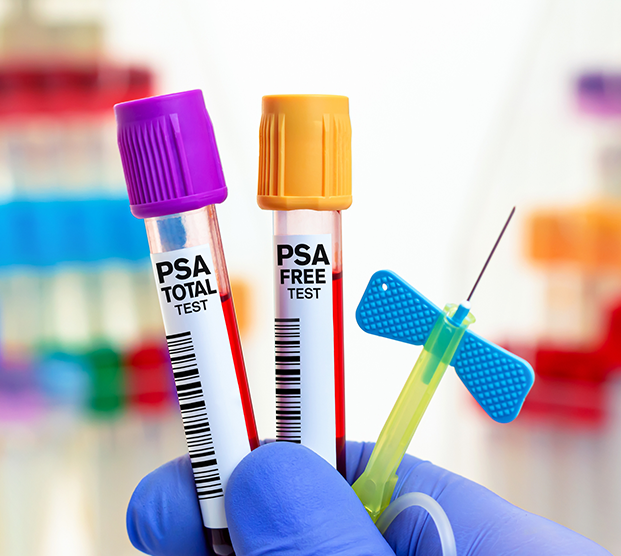
The prostate gland produces prostate-specific antigen, or PSA. An issue with the prostate gland can cause it to release more PSA.
Patients with elevated prostate-specific antigen (PSA) levels may have prostate cancer. Elevated PSA can also indicate noncancerous problems such as inflammation and prostate enlargement. The patient’s physician will take steps to identify the cause of elevated PSA.


Diagnosing Elevated PSA
The medical community hasn’t settled on a single normal PSA level. Previously, patients with a level of 4.0 ng/mL or higher would need to undergo more testing, typically a prostate biopsy. During the biopsy, the physician removes a small sample of prostate tissue to screen for cancer.
However, when testing PSA levels physicians now take into consideration other issues to decide whether the patient needs a biopsy. The patient’s age, general health, and family and health history will be factors in their decision.
PSA levels are measured through a blood test. The physician may perform a digital rectal exam (DRE) in addition to a PSA test to check for signs of prostate cancer. During a DRE, the provider inserts a gloved finger into the patient’s rectum to feel for bumps or other irregularities.
Depending on the results of the initial PSA test, the patient may need to repeat the test because PSA levels can fluctuate. A second test will give the physician greater details about the patient’s prostate health.




Diagnosing Prostate Cancer by PSA Level
When evaluating the test results, the physician will look at two factors related to PSA:
PSA level: A higher level indicates a higher risk of prostate cancer.
- Changes in PSA level: PSA levels that show a continued increase after two or more tests could indicate cancer.
Other Risk Factors for Prostate Cancer
Patients may be at higher risk of prostate cancer if they:
Are 50 years of age or older
Are of African-American or Caribbean descent
Have a family history of prostate cancer
Are genetically predisposed to developing prostate cancer
Causes of Elevated PSA Level
The main cause of elevated PSA is prostate cancer. However, PSA levels increase with age and can indicate a range of prostate conditions. Other factors that may elevate a patient’s PSA level include:
Prostate enlargement (BPH)
Prostate inflammation (prostatitis)
Urinary catheter (tube) placement
Urinary tract infection
Symptoms Caused by Elevated PSA
Patients usually have no symptoms related or caused by elevated PSA level or prostate cancer. It is recommended men should screen with a PSA test apart from symptoms indicators. The following symptoms may also be needed to undergo a PSA test:
:
Slow urine stream
Difficulty urinating
Frequent urination, including during the night
- Urinary incontinence (difficulty holding urine in)
MRI/US Fusion Biopsy
MRI/US fusion biopsy incorporates traditional biopsy methods with technologically advanced imaging to identify prostate cancer.
Before undergoing an MRI/US fusion biopsy, the patient may need to utilize an enema. An MRI scan is completed during a separate visit where a radiologist will mark concerning areas and the urologist will college ultrasound images. Technology like the ARTEMIS machine will combine these images in real time to allow the physician to obtain a biopsy. The length of the biopsy procedure will vary based on the number of problem areas that need to be sampled. Typically, patients are able to go home immediately after the testing.
Transperineal Biopsy
During a transperineal biopsy, a needle is passed through the perineal skin and into the prostate. This type of biopsy may have a higher yield than a biopsy obtained using the transrectal approach. Avoiding transrectal biopsies also greatly reduces the risk of infection.
The procedure may be done under local or general anesthesia.
If the biopsy is done under local anesthetic, the physician will inject the medication into the perineum to numb the area. An ultrasound probe will then be inserted into the rectum to visualize the prostate gland and guide the biopsy needle into the prostate. Using an MRI/US fusion technology, the physician will identify the best locations to insert the biopsy needle.
